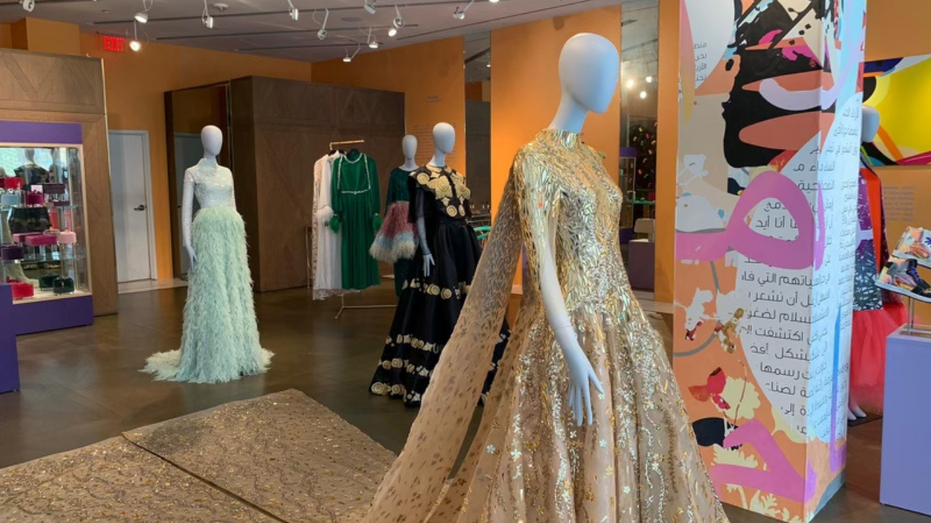The black protagonists of Alison Saar’s sculptures, work and installations face innumerable masses – some steadiness masses on their heads; others dangle on chairs, materials or ropes – but they by no means appear to lose their braveness or their potential to behave. The expression of every determine conveys an indomitable spirit.
The on a regular basis instruments of girls and even their our bodies are sometimes given magical powers, for instance within the portray “Excessive Cotton” (2017), the place plantation utensils additionally function weapons for a practice of enslaved ladies. Mystically cotton-covered branches sprout from her deep blue hair as a camouflage in a nocturnal subject.
This work is considered one of almost 30 works that comprise Of Aether and Earthe, an exhibition that gives a fowl’s eye view of the intersection of black and femininity in Saar’s work over the previous 4 many years. Their largest museum survey thus far consists of two Los Angeles County venues, the Benton Museum of Artwork at Pomona Faculty in Claremont and the Armory Middle for the Arts in Pasadena.
Alison Saar, whose work is being examined in her largest museum exhibition thus far © New York Instances / Redux / eyevine
The curators Rebecca McGrew and Irene Tsatsos have cleverly used the forked format to play with dualities. By mixing the myths of historic Greece with folklore and traditions from Africa and past, Saar’s work usually offers the sensation of two realms spreading. The title of the exhibition underlines the dichotomy between physique and soul that runs via her oeuvre and refers back to the 5 basic parts of historic Greece: earth, air, hearth, water and ether. It additionally carries alchemical connotations, suggesting the transmutative nature of their apply of giving new meanings to discovered objects and historic icons.
Saar’s broad educational background in artwork historical past is clear within the stiff poses and simplified types of her lonely figures, which seem simply as indebted to the Greek male Kouroi statues because the stone-carved sculptures of the self-taught southern folks artist William Edmondson – as in “Sea of Tranquility” (2007) . Her stylized motifs are sometimes harking back to Gauguins, however they undermine the traditions of the feminine nude as a passive object of want: yours characterize energetic forces of transformation.
In stark distinction to the sleek, pliable flesh that has been fetishized all through Western artwork historical past, these girls are constituted of a tougher materials: wooden, nails, salvaged steel hammered into repoussé bas-relief patterns. They put on their tales scarred on their our bodies, as in “Scar Track” (1989). Including to the sober temper, the Saar palette consists primarily of earth tones punctuated by fiery reds and oceanic blues.
‘Sea of Serenity’ (2007) © Ian Byers-Gamber
Executed on sacks of seeds and denim, even her footage are torn, wounded and patched up. Worn however resilient, they’re harking back to African American quilts and the male-dominated, utilitarian Ghanaian custom of portray film posters on discarded materials.
Saar remembered rising up in Laurel Canyon, LA, amassing discarded gadgets and making clever backstory dolls for her dad and mom to show in her sales space on the native Renaissance amusement truthful (a competition that gives a historic backdrop replicated) on the market. , an exercise to which she ascribes the narrative content material of her work.
The earliest work within the exhibition, “Voluptuous Mummy” (1982), is doll-like in dimension and a centerpiece of the Benton present. The third sculpture, which she made shortly after her MFA, depicts what the artist, who beforehand most well-liked abstraction, calls the “epiphany second” when she describes figuration as a “direct mind-set about summary concepts of the spirit and the artwork of talking “accepted unseen”.

‘Sapphire’ (1985) © Ian Byers-Gamber

‘Legacy’ (2003) © Ian Byers-Gamber
This piece hints on the feminine figures and basic references that outline her work, exhibiting a curved physique wrapped in scraps of linen that she drew from the trimmings of nineteenth century work. His face, a tiny mosaic, displays the affect of her mom, the assemblage artist Betye Saar.
There’s a equally compelling feminine character in “Breach,” a portion of her 2015-17 work that portrays the nice Mississippi flood of 1927, Hurricane Katrina in 2005, and the bureaucratic abuse and misconduct that aggravated the plight of blacks , was impressed by congregations to comply with them. The life-size lady stands alone with a pole on a wood raft, as if the gallery flooring had been flooded with water. An enormous pile of suitcases and sinks rises above her head and virtually reaches the ceiling. Unimpressed by the flood and its atlas-like burden, she stands upright and dignified and provides the sensation that she’s going to survive and obtain a greater aim. It appears equally related to current scenes of Hurricane Ida and floods in Haiti.
Whereas the Benton’s presentation focuses on terrestrial and aquatic themes, work within the Armory is extra ethereal and religious, with sculptures with dangling figures, balancing acts, and propulsion powers. The motif of “Blonde Desires” (1997) hangs on her ankles, tied to Eurocentric beliefs of magnificence that devalue the pure hair of black girls. Her lengthy, straight mane shimmers with gold leaf, however her physique is roofed in tar.
“Brut” (2008); Saar stated the sculpture got here partly from her personal expertise with menopause © Ian Byers-Gamber
Cultures all over the world glorify superficial indicators of feminine fertility, at the same time as they power girls to cover extra practical reproductive traits. Saar questions this and sheds mild on the miracle of menstruation and lactation, suggesting that such phenomena may very well be mystical powers. Creepy lyrics permeate “Undone” (2012), by which a woman sits in a floating chair, clutching the folds of her flowing white gown, the translucence of which barely hides a blood-red department that extends downward and is tied with ribbons and bottles.
Close by, the protagonist of “Brood” (2008) crouches precariously on a pile of wood youngsters’s chairs and stares via her fingers at a fallen pomegranate. A pile of fruit is rotting down on the ground; nobody stays inside attain. Her stressed environment is intensified, her complexion is speckled and bloody juice drips down her legs. The artist says this sculpture got here partly from her personal expertise with menopause shortly after her daughter was born.
Though rooted in very private episodes, the conditions and themes of Saar’s work are timeless and common. By taking on myths from probably the most various cultures and epochs, the artist succeeds in creating open totems whose social feedback can adapt to new situations.
In ‘Hygiea’ (2020) a cleansing woman is reinvented because the Greek goddess of hygiene © Ian Byers-Gamber
This exhibition was conceived previous to Covid-19 and final 12 months’s anti-racial protests, however their two latest items, each of which concentrate on the cleaning, appear eerily apt for a society making an attempt to purify its air of an infection and injustice alike . In “Hygiea” (2020) a modest cleansing woman is reinterpreted because the Greek goddess of hygiene, who wields a silver double broom as a magic wand. Imbued with a soothing soundtrack of bends and drops, the dimly lit chamber by which she lives is harking back to a janitor’s cabinet adorned with mysterious bottles and pans in a secret haven.
Along with her studio apply, Saar is a productive sculptor in public areas. The Benton christened its newly constructed constructing by commissioning a site-specific sculpture “Imbue” (2020), which is included on this exhibition. Dipped in an aquamarine-colored patina, it reveals a contemporary laundress as Yemoja, the West African water deity, within the arid panorama of a courtyard. There she’s going to stand indefinitely, pouring bronze water ceaselessly to symbolically cleanse of all evils that will come.
‘Alison Saar: Of Aether and Earthe’ runs till December twelfth on the Armory Middle for the Arts in Pasadena and till December nineteenth on the Benton Museum of Artwork at Pomona Faculty in Claremont
















